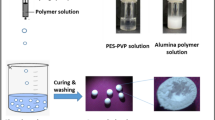Abstract
Rice husk (RH) agro-waste was used as a raw material for synthesizing mesoporous molecular sieves, MCM-41. The Fe-MCM-41 was prepared by the hydrothermal technique (HT), resulting in a higher surface area and crystallinity than when prepared under ambient conditions. In addition, a hexagonal structure was clearly seen with hydrothermal technique (HT) preparation. The adsorption of arsenate by HT-Fe-MCM-41 was investigated. The factors studied affecting arsenate adsorption capacity were ferric content in MCM-41, contact time, pH of solution, and initial arsenate concentration. It was found that HT-Fe-MCM-41 at the Si/Fe mole ratio of 10 gave the highest adsorption capacity. Arsenate adsorption reached equilibrium within 4 h. The adsorption capacity of HT-Fe-MCM-41 (Si/Fe = 10) was affected by the initial pH value and the initial arsenate concentration. The adsorption capacity was highest at pH 3 and decreased thereafter with increases in the pH of solution value. The Langmuir model fit the arsenate adsorption isotherm well. The maximum adsorption capacity for arsenate was 1,111 μg g−1.






Similar content being viewed by others
References
Chen, W., Parette, R., Zou, J., Cannon, F. S., & Dempsey, B. A. (2007). Arsenic removal by iron-modified activated carbon. Water Research, 41, 1851–1858.
Chiarakorn, S., Areerob, T., & Grisdanurak, N. (2007). Influence of functional silanes on hydrophobicity of MCM-41 synthesized from rice husk. Science and Technology of Advanced Materials, 8, 110–115.
Chumee, J., Grisdanurak, N., Neramittagapong, A., & Witthayakun, J. (2009). Characterization of platinum-iron catalyst supported on MCM-41 synthesized with rice husk silica and their performance for phenol hydroxylation. Science and Technology of Advanced Materials, 10, 015006.
Dinesh, M., & Charles, U. P. Jr. (2007). Arsenic removal from water/wastewater using adsorbents—a critical review. Journal of Hazardous Materials, 142, 1–53.
Grisdanurak, N., Chairakorn, S., & Wittayakun, J. (2003). Utilization of mesoporous molecular sieves synthesized from natural source rice husk silica to chlorinated volatile organic compounds (CVOCs) adsorption. Korean Journal of Chemical Engineering, 20(5), 950–955.
Gupta, V. K., Saini, V. K., & Jain, N. (2005). Adsorption of As (III) from aqueous solutions by iron oxide-coated sand. Journal of Colloid and Interface Science, 288, 55–60.
Katsoyiannis, I. A., & Zouboulis, A. I. (2002). Removal of arsenic from contaminated water sources by sorption onto iron-oxide-coated polymeric materials. Water Research, 36, 5141–5155.
Kundu, S., & Gupta, A. K. (2006). Arsenic adsorption onto iron oxide-coated cement (IOCC): regression analysis of equilibrium data with several isotherm models and their optimization. Chemical Engineering Journal, 122, 93–106.
Mondal, P., Balomajumder, C., & Mohanty, B. (2007). A laboratory study for the treatment of arsenic, iron and manganese bearing ground water using Fe3+ impregnated activated carbon: effect of shaking time, pH and temperature. Journal of Hazardous Materials, 144, 420–426.
Smedley, P. L., & Kinniburgh, D. G. (2002). A review of the source, behavior and distribution of arsenic in natural waters. Applied Geochemistry, 17, 517–568.
Song, S., Lopez, V. A., Hernandez, D. J., Peng, C., Monroy, M. G., & Razo, R. I. (2006). Arsenic removal from high-arsenic water by enhanced coagulation with ferric ions and coarse calcite. Water Research, 40, 364–372.
Sthiannopkao, S., Kim, K. W., Sotham, S., & Chop, S. (2008). Arsenic and manganese in tube well waters of Prey Veng and Kandal Provinces, Cambodia. Applied Geochemistry, 23, 1086–1093.
Tong-on, W., Chiarakorn, S., Sthiannopkao, S., & Kim, K. W. (2009). Adsorption of arsenic in aqueous solution by RH-Fe-MCM-41. Water Science & Technology: Water Supply, 9(2), 121–126.
Zhang, F. S., & Itoh, H. (2005). Iron oxide-loaded slag for arsenic removal from aqueous system. Chemosphere, 60, 319–325.
Zhang, Q., Yang, W., Wang, X., Wang, Y., Shishido, T., & Táchira, K. (2005). Coordination structures of vanadium and iron in MCM-41 and the catalytic properties in partial oxidation of methane. Microporous and Mesoporous Materials, 77, 223–234.
Acknowledgments
Financial support was provided by the International Environmental Research Center at Gwangju Institute of Science and Technology (GIST), Republic of Korea.
Author information
Authors and Affiliations
Corresponding authors
Rights and permissions
About this article
Cite this article
Wantala, K., Sthiannopkao, S., Srinameb, Bo. et al. Synthesis and characterization of Fe-MCM-41 from rice husk silica by hydrothermal technique for arsenate adsorption. Environ Geochem Health 32, 261–266 (2010). https://doi.org/10.1007/s10653-010-9292-z
Received:
Accepted:
Published:
Issue Date:
DOI: https://doi.org/10.1007/s10653-010-9292-z




